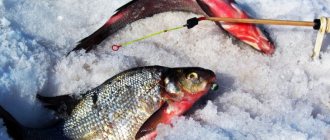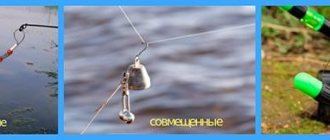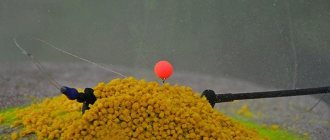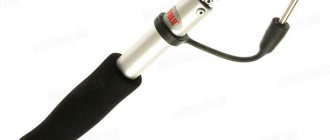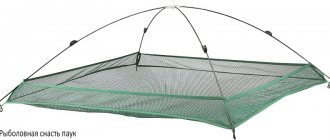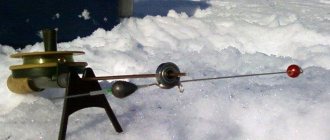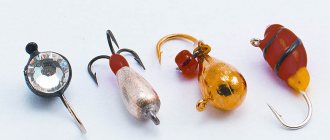In order to increase the catch, experienced fishermen feed the fish without fail. If in summer you can simply throw complementary foods into the water, then in winter this method will not work. In the cold season, due to low temperatures, the fish becomes lethargic and its activity decreases.
You can simply take the food, roll it into a ball and throw it into the water. Provided there is no current, this method may bring results, but it is much better to use a feeder. It helps deliver complementary food exactly to its destination without losing it in the water column.
How do ice fishing feeders work?
The purpose of the feeder is to deliver complementary foods exactly to the destination area. To do this, the depths are measured at the place where the fish are caught, and then bait is poured into the feeder container. If the current is strong, it is advisable to use a more sticky mixture; if the current is weak, you can use a crumbly one. There is a lid at the bottom that needs to be closed.
Read here Do-it-yourself bloodworm - how to make it at home and strengthen it for winter and summer fishing (115 photos + video)

In places with strong currents, a separate hole is drilled for the described device, 2-3 meters upstream. The feeder is not pulled out, but left at the bottom or suspended near the very bottom.
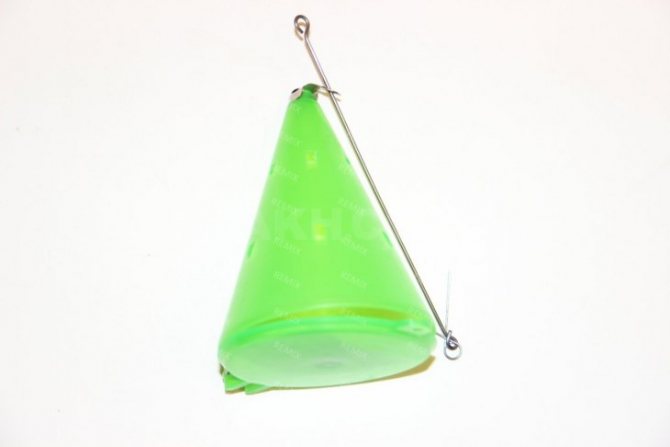
The lid should be closed and the complementary food should be dense. Through the holes in the feeder, the complementary food, along with the underwater current, will fall exactly to the place where the fisherman sits with a fishing rod. To stabilize the feeder, you can use a weight.

When it is necessary?
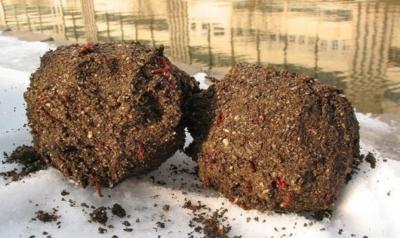
Winter bait differs from summer bait, since fish mostly live in the bottom layers, so in winter it is important to deliver bait to the bottom.
- At shallow depths of up to 3 meters, a bait ball lowered into a hole will reach the bottom and disintegrate there, forming a concentrated bait cloud.
- At a depth of up to 2 meters, sinking complementary foods can be directly introduced in handfuls into the hole of a reservoir with standing water.
- At a depth of 4 m or more, the bait ball will most likely disintegrate far from the bottom, particles of bait will be scattered over a large area under the hole, and fish will not accumulate in one place near the hook with the nozzle. In this case, it is impossible to do without a means of delivering complementary foods to the bottom layers of the reservoir. Need a winter feeder.
Expert opinion
Knipovich Nikolai Mikhailovich
Zoologist, hydrobiologist. I am interested in fishing at a professional level.
In reservoirs with a current, a ball of bait thrown into a hole will disintegrate faster than in stagnant water; the current will quickly carry away particles of bait.
To prevent this from happening in bodies of water with a current, it is necessary to use winter feeders to gradually and evenly deliver particles of complementary food to the fishing point.
Should I buy feeders or make my own?
The finished device can be purchased at specialized fishing stores. They can be in the shape of a cone, cylinder or rectangle.
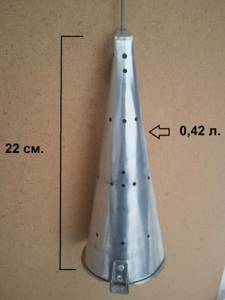
How to choose a device?

- As a rule, in calm waters, an inexpensive cone feeder with an opening lid is used for the first bulk feeding.
The disadvantage of an iron feeder with a lock in the form of antennae is that opening the lid is accompanied by a clanging noise from the lock, which scares away the fish.Expert opinion
Knipovich Nikolai Mikhailovich
Zoologist, hydrobiologist. I am interested in fishing at a professional level.
It is strictly not recommended to use such a feeder in a place explored by an echo sounder, where there is a school of fish. It is better to use a feeder made of plastic.
Another option is a homemade or purchased feeder with an opening lid with a lock in the form of a bracket.
Opening the lid occurs almost silently due to the sharp jerking of the fishing line. You can slightly bend or straighten the bracket, thereby changing the locking force of the lock.
Subsequent feedings are carried out in smaller volumes. You can use small sports cone feeders.
- For live food, closed feeders with large diameter holes are used.
- On the current, specialized winter mesh commercial feeders with lead loading are most often used, most often rectangular or triangular in shape to prevent rolling along the bottom, volumetric rectangular feeder lattice feeders.
DIY making
If you are interested in the question of how to make a feeder for winter fishing, you should stock up on a square sheet of tin. Using cardboard you need to make a cone, and unfold it to get a template. After adding a few millimeters for bending, a similar figure is cut out of a tin sheet. Holes are made using a drill or nail. Now you need to make a cone from the workpiece and fix its shape using a soldering iron.
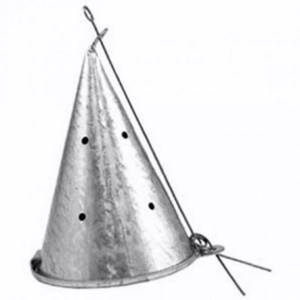
Also, a ring is attached to the top of the future feeder, and a cord is tied through it to hold the fishing unit. The bottom of the cone is cut 2-3 mm larger. A loop can be made from the extreme part of the cone. The lid and cone should rotate like a door hinge. A cord is threaded through the ring (this point is presented in detail in the drawings of feeders for winter fishing).

Using the second latch, the opening of the feeder is regulated. This retainer is made of wire. After filling the feeder, the wire must be passed through the hole made for this purpose in the bottom of the lid, and the mustache must be bent.
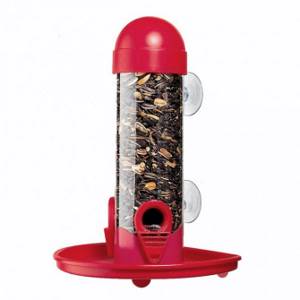
When the feeder is lowered to the bottom, with a sharp jerk, the wire will fly out, the food will fall to the bottom, and the tackle will hang on the latch and will be successfully removed from the water.

Handmade winter fishing feeders have many advantages. You don’t need to spend money to purchase them, the manufacturing process is not particularly difficult, the quality is much better, and there is also a lot of room for creativity.
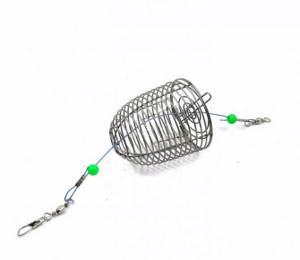
Alternative manufacturing methods
While fishing, the line on the feeder can break and it will remain at the bottom. The feeder may get firmly caught on a snag. You can just forget it at home. Then you can quickly and on the spot make a dump truck feeder from available materials.
From paper
A sheet of paper is rolled up into a ball. A fishing line is tied to its top. The bait is loaded inside, and the edges are tucked in. While sinking to the bottom, the water, on the one hand, prevents the paper from unfolding, and on the other hand, it saturates it. When such an improvised feeder touches the bottom, you should make a sharp jerk so that the edges straighten and the bait falls out. This type of feeder will not last long. Most likely, no more than once. But in a difficult situation it will help out.
From a polyethylene bag
To make this type of dump truck feeder, you will need not only a plastic bag, but also a bolt. The bag must be cut so that it forms a cone. A bolt is attached to the very corner using a thread or fishing line - thread down, head up. The fishing line, by which the feeder will be lowered into the hole, is tied to the head of the bolt. The design should be obtained when the bolt is inside the bag. Bait is placed inside, and the feeder is carefully lowered into the hole. The water will support the edges. You should make a jerk near the bottom. The plastic bag will simply turn out and the bait will end up at the bottom.
Feeder
Feeder feeders for ice fishing differ from their summer counterparts in being smaller in size and weight. Depending on the strength of the current, they can weigh from ten to forty grams; more is usually not required.
If the store doesn’t have feeders with the parameters necessary for winter fishing, you can easily make them yourself.
There are several manufacturing methods, but the simplest of them are two:
- made of metal mesh;
- from a plastic tube or curler.
Metal mesh feeders
To make this feeder we will need:
- metal grid;
- wire;
- lead;
- plaster or other form.
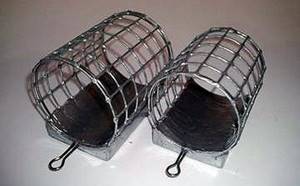
Here is a description of the manufacturing process:
- Cut out the required piece from the mesh.
- We fold it in the form of a square or triangle in cross-section, and tie the free edges with thin wire.
- We tie a loop for fastening to the equipment.
- We make a hole in the mold for filling. In addition to gypsum, ordinary clay is also suitable, because the pouring will be done from above.
- We wait for the wife to leave the house and put a container of lead on the stove.
- We pour the molten lead into the mold and immediately insert the mesh there, with its edges connected into the metal.
Plastic tube feeders
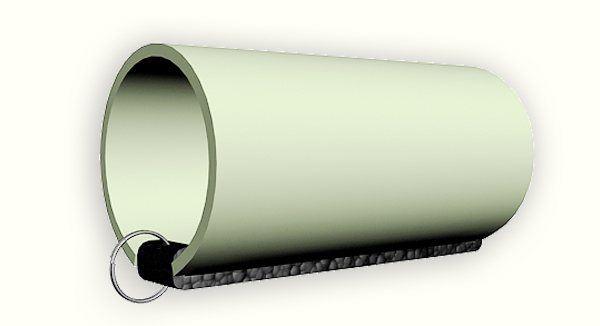
This method of making a feeder with your own hands is safer; you can also work with your household.
- From a plastic tube, or HDPE, of small diameter, 15-20 millimeters, cut off a piece of 3-4 centimeters.
- From a lead plate (it can be purchased at the radio market) we cut a strip slightly longer than the tube.
- In the upper and lower edges of the tube on one side we cut out grooves as wide as a lead plate.
- We press the plate against the tube and bend its ends inward through the grooves.
- Using an awl, we make a hole in the lead plate and tube.
- We attach a wire loop for fishing line to the hole.
What to use for bait
Basically, 2 types of bait are used: porridge and dry mixtures. The porridge is cooked at home in advance, and the mixture can be prepared right at the fishing spot. It is recommended to take water for the mixture directly from the hole. The food needs to be kept in a warm place so that it retains heat for as long as possible.
A good bait porridge contains wheat grits, as well as various additives, flavorings, and pheromones. All this is selected depending on what kind of fish you plan to fish.
Next, we’ll look at a few simple and popular feeding recipes. To prepare, you will need a base that will make it sticky, and a crumbly additive. For example, for catching bream, the ideal choice would be peas and millet, but pearl barley and corn would be just good.
Another popular bait recipe :
- You need to take breadcrumbs.
- Add bran – 20%.
- Cake – 15%.
- Semolina – 10%.
- Porridge “Hercules” – 10%.
- The remainder is any flavor from the store.

Using such bait even on days when the bite is very bad, in any case the fisherman does not return home empty-handed. That is why many fishermen value this “universal” composition . It also cooks quite quickly.
Winter fishing rods for roach with a nod
The most convenient and working winter tackle for roach for fishing in the current is a fishing rod with a nod and a heavy sinker. For large fish, the fishing rod can be equipped with a heavy jig. But this option is not suitable for roach, so a sliding olive or a blind weight at the bottom with a retractable leash is used. The weight of the sinker is selected based on the strength of the current, most often from 5 to 30 grams. This fishing rod can also be used as equipment for fishing without a current, for example, in reservoirs at depths of 5-6 meters. Simply lowering a light fishing rod to the bottom in such conditions takes too long.
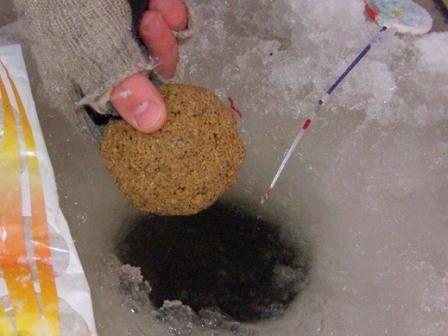
With sliding sinker
The simplest equipment for catching roach in the winter on the current is a sliding sinker, a stopper, a leash and a hook. Important points of such a fishing rod:
- A fairly large and heavy fishing rod (a small and light one will be pulled away from the installation site).
- Strong fishing line about 14-0.18 (when fishing for roach in the current and good depth, bream, large silver bream, and chub can bite).
- A fairly elastic metal nod that can withstand the pressure of the flow.
When biting, the line is pulled through the sinker, a nod shows this well.
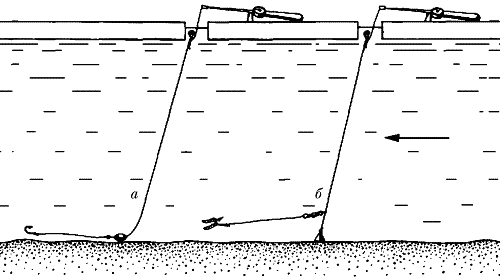
With retractable leash
A rig with a retractable lead is more versatile than a rig with a sliding sinker. In winter, roaches can stand either at the bottom or in the middle of the water. If you make a diverter leash on a loop with two stoppers, you can set the depth by raising the working part higher or lowering it lower along the main line, thus fishing the entire thickness of the water. A blind weight is installed at the end of the fishing line, holding all the gear at the bottom.
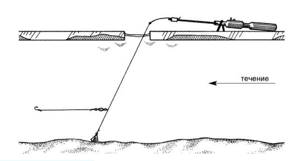
Feeder rigs - a life hack for ice fishing for roach
Tackle for catching roach in winter on the current can be equipped according to the principle of feeder rigs, only in miniature. A paternoster, asymmetrical loop or inline in a smaller version can be easily knitted with your own hands. Instead of a sinker, you can attach a small feeder. Experience confirms that such experiments on roach work well.
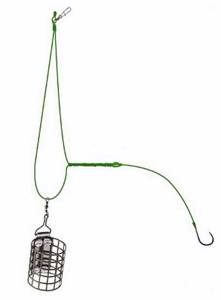
Heavy Tooling
Sometimes you have to catch roach in conditions of great depth and a very strong current, when light tackle simply cannot stay on the bottom. For example, on fast northern and Siberian rivers, you can successfully use helicopter gear to catch sorog (chebak) in the current in winter. A heavy sinker is installed at the end of the fishing line; a piece of monofilament with several leads is attached as a lead, the end of which is attached to a specially shaped blade using a swivel.
Thanks to this blade, the working part stretches with the flow and maneuvers with a certain amplitude to the left and right. At the top, the fishing line is attached to a nod or a homemade signaling device. The helicopter can be made sliding, which will allow you to change the fishing horizon.
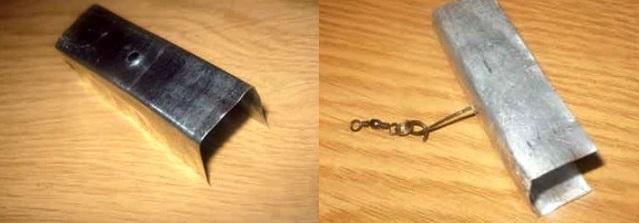
Ride
In Siberia, rolling is used to catch chebak in the current in winter. The installation of this fishing rod is a round sliding sinker and a leash with a hook. The point of fishing is that the tackle is released far enough under the ice, the sinker with the hook rolls along the bottom. Naturally, such fishing is only possible in areas with a clean bottom. The tackle is equipped with a powerful fishing rod with a reel and a nod that can withstand strong currents. The hole needs to be drilled slightly at an angle, with the flow, this will make the process of managing the gear easier.
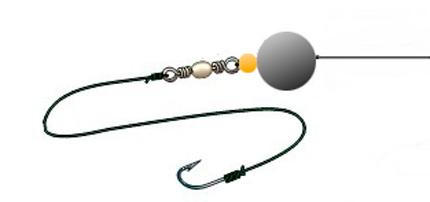
For all roach fishing gear in winter, it is advisable to use relatively small, sharp hooks and thin, strong fishing lines. If for the northern regions and Siberia, where there is a lot of fish, this is not very relevant, then in the urbanized European part of the country, roaches in winter simply will not be taken with a rough fishing rod.

